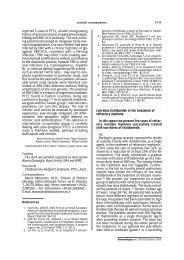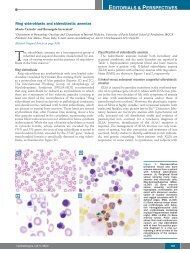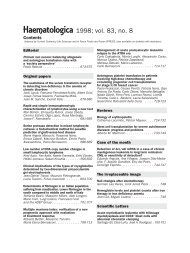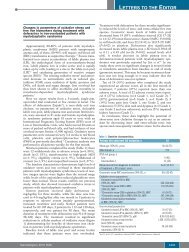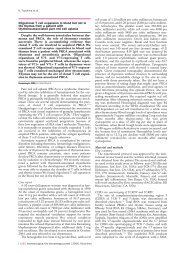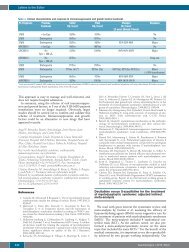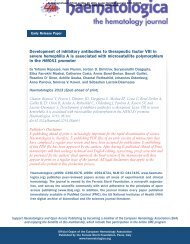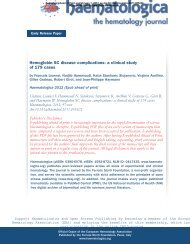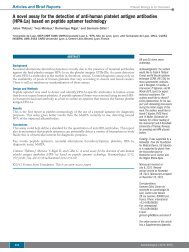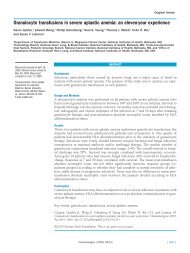ALK-positive anaplastic large cell lymphoma ... - Haematologica
ALK-positive anaplastic large cell lymphoma ... - Haematologica
ALK-positive anaplastic large cell lymphoma ... - Haematologica
Create successful ePaper yourself
Turn your PDF publications into a flip-book with our unique Google optimized e-Paper software.
Early Release Paper<br />
Published Ahead of Print on July 6, 2012, as doi:10.3324/haematol.2012.065664.<br />
Copyright 2012 Ferrata Storti Foundation.<br />
<strong>ALK</strong>-<strong>positive</strong> <strong>anaplastic</strong> <strong>large</strong> <strong>cell</strong> <strong>lymphoma</strong> limited to the skin:<br />
clinical, histopathological and molecular analysis of 6 pediatric<br />
cases- a report from the ALCL99 study<br />
by Ilske Oschlies, Jasmin Lisfeld, Laurence Lamant, Atsuko Nakazawa,<br />
Emanuele D' Amore, Ulrika Hansson, Konnie Hebeda, Ingrid Simonisch-Klupp,<br />
Jadwiga Maldyk, Leonhard Muellauer, Marianne Tinguely, Markus Stuecker,<br />
Marie-Cecile Ledeley, Reiner Siebert, Alfred Reiter, Laurence Brugieres,<br />
Wolfram Klapper, and Wilhelm Woessmann<br />
<strong>Haematologica</strong> 2012 [Epub ahead of print]<br />
Citation: Oschlies I, Lisfeld J, Lamant L, Nakazawa A, D' Amore E, Hansson U,<br />
Hebeda K, Simonisch-Klupp I, Maldyk J, Muellauer L, Tinguely M, Stuecker M,<br />
Ledeley MC, Siebert R, Reiter A, Brugieres L, Klapper W, and Woessmann W.<br />
<strong>ALK</strong>-<strong>positive</strong> <strong>anaplastic</strong> <strong>large</strong> <strong>cell</strong> <strong>lymphoma</strong> limited to the skin: clinical, histopathological<br />
and molecular analysis of 6 pediatric cases- a report from the ALCL99 study.<br />
<strong>Haematologica</strong>. 2012; 97:xxx<br />
doi:10.3324/haematol.2012.065664<br />
Publisher's Disclaimer.<br />
E-publishing ahead of print is increasingly important for the rapid dissemination of science.<br />
<strong>Haematologica</strong> is, therefore, E-publishing PDF files of an early version of manuscripts that<br />
have completed a regular peer review and have been accepted for publication. E-publishing<br />
of this PDF file has been approved by the authors. After having E-published Ahead of Print,<br />
manuscripts will then undergo technical and English editing, typesetting, proof correction and<br />
be presented for the authors' final approval; the final version of the manuscript will then<br />
appear in print on a regular issue of the journal. All legal disclaimers that apply to the<br />
journal also pertain to this production process.<br />
<strong>Haematologica</strong> (pISSN: 0390-6078, eISSN: 1592-8721, NLM ID: 0417435, www.haematologica.org)<br />
publishes peer-reviewed papers across all areas of experimental and clinical<br />
hematology. The journal is owned by the Ferrata Storti Foundation, a non-profit organization,<br />
and serves the scientific community with strict adherence to the principles of open<br />
access publishing (www.doaj.org). In addition, the journal makes every paper published<br />
immediately available in PubMed Central (PMC), the US National Institutes of Health (NIH)<br />
free digital archive of biomedical and life sciences journal literature.<br />
Support <strong>Haematologica</strong> and Open Access Publishing by becoming a member of the Europe<br />
Hematology Association (EHA) and enjoying the benefits of this membership, which inc<br />
participation in the online CME?program<br />
Official Organ of the European Hematology Association<br />
Published by the Ferrata Storti Foundation, Pavia, Italy<br />
www.haematologica.org
<strong>ALK</strong>-<strong>positive</strong> <strong>anaplastic</strong> <strong>large</strong> <strong>cell</strong> <strong>lymphoma</strong> limited to the skin: clinical,<br />
histopathological and molecular analysis of 6 pediatric cases- a report<br />
from the ALCL99 study<br />
Running title: Pediatric <strong>ALK</strong>-<strong>positive</strong> cutaneous <strong>anaplastic</strong> <strong>large</strong> <strong>cell</strong> <strong>lymphoma</strong><br />
Ilske Oschlies 1 , Jasmin Lisfeld 2 , Laurence Lamant 3 , Atsuko Nakazawa 4 ,<br />
Emanuele S.G. d’Amore 5 , Ulrika Hansson 6 , Konnie Hebeda 7 , Ingrid Simonitsch-Klupp 8 ,<br />
Jadwiga Maldyk 9 , Leonhard Müllauer 8 , Marianne Tinguely 10 , Markus Stücker 11 ,<br />
Marie-Cecile Ledeley 12 ,Reiner Siebert 13 , Alfred Reiter 2, , Laurence Brugières 14 ,<br />
Wolfram Klapper 1 , and Wilhelm Woessmann 2<br />
1<br />
Department of Pathology, Hematopathology Section and Lymph Node Registry,<br />
Christian-Albrechts-University Kiel and University Hospital Schleswig-Holstein, Campus Kiel,<br />
Kiel, Germany; 2 NHL-BFM Study Center, Department of Pediatric Hematology and Oncology,<br />
Justus-Liebig University, Giessen, Germany; 3 Laboratoire Anatomie Pathologique, Centre<br />
Hospitalier Universitaire PurpanToulouse, France; 4 Department of Pathology, National<br />
Center for Child Health and Development,Tokyo, Japan; 5 UO di Anatomia Patologica,<br />
Ospendale San Bortolo,Vicenza, Italy; 6 Avdehingen foer patologi, Sahlgrenska<br />
Universitetssjukhuset, Gothenburg, Sweden; 7 Radbound University Nijmegen Medical<br />
Centre, Department of Pathology, Nijmegen, The Netherlands; 8 Institute of Pathology,<br />
Medical University Vienna, Vienna, Austria; 9 Department of Pathology, Childrens Hospital,<br />
Warsaw, Poland; 10 Institute of Surgical Pathology, University Hospital Zurich, Zurich,<br />
Switzerland; 11 Department of Dermatology and Allergology, Ruhr University Bochum,<br />
St. Joseph; 12 Department of Biostatistics, Institut Gustave Roussy, Villejuif, France;<br />
13<br />
Institute of Human Genetics, Christian-Albrechts-University Kiel and University Hospital<br />
Schleswig-Holstein, Campus Kiel, Kiel, Germany, University of Kiel, Kiel, Germany,<br />
and 14 Department of Pediatric Oncology, Institut Gustave Roussy, Villejuif, France<br />
Correspondence<br />
DOI: 10.3324/haematol.2012.065664<br />
Ilske Oschlies, Department of Pathology, Hematopathology Section and Lymph Node<br />
Registry, Christian-Albrechts-University Kiel and University Hospital Schleswig-Holstein,<br />
Campus Kiel, Michaelisstr. 11, 24105 Kiel, Germany.<br />
Phone: international +0049.431.5973425. Fax: international +0049.431.5974129.<br />
E-mail: ioschlies@path.uni-kiel.de<br />
1
DOI: 10.3324/haematol.2012.065664<br />
Key words: Primary cutaneous CD30-<strong>positive</strong> T-<strong>cell</strong> lymphoproliferative disorder, child,<br />
primary cutaneous <strong>anaplastic</strong> <strong>large</strong> <strong>cell</strong> <strong>lymphoma</strong><br />
2
Abstract<br />
Background<br />
Anaplastic <strong>large</strong> <strong>cell</strong> <strong>lymphoma</strong>s are peripheral T-<strong>cell</strong> <strong>lymphoma</strong>s that are characterized by a<br />
proliferation of <strong>large</strong> <strong>anaplastic</strong> blasts expressing CD30. In children systemic <strong>anaplastic</strong> <strong>large</strong><br />
<strong>cell</strong> <strong>lymphoma</strong>s often present at advanced clinical stage and harbor translocations involving<br />
the <strong>anaplastic</strong> <strong>lymphoma</strong> kinase (<strong>ALK</strong>) gene leading to the expression of chimeric <strong>anaplastic</strong><br />
<strong>lymphoma</strong> kinase (<strong>ALK</strong>)-fusion proteins. Primary cutaneous <strong>anaplastic</strong> <strong>large</strong> <strong>cell</strong> <strong>lymphoma</strong><br />
is regarded as an <strong>ALK</strong>-negative variant confined to the skin and is part of the spectrum of<br />
primary cutaneous CD30-<strong>positive</strong> T-<strong>cell</strong> lymphoproliferative disorders.<br />
Design and Methods<br />
33/487 pediatric patients registered within the Anaplastic Large Cell Lymphoma-99 trial<br />
(1999 to 2006) presented with a skin limited CD30-<strong>positive</strong> lymphoproliferative disorder. In<br />
23/33 patients material for international histopathological review was available and the cases<br />
were studied for histopathological, immunophenotypical and clinical features as well as for<br />
breaks within the <strong>ALK</strong> gene.<br />
Results<br />
5/23 cases and one additional case -identified after closure of the trial- expressed <strong>ALK</strong>protein.<br />
Complete staging excluded any other organ involvement in all children. Expression<br />
of <strong>ALK</strong> proteins was demonstrated by immunohistochemistry in all cases and the presence of<br />
breaks of the <strong>ALK</strong> gene was genetically confirmed in five evaluable cases. The<br />
histopathological and clinical picture of these skin-restricted <strong>ALK</strong>-<strong>positive</strong> <strong>lymphoma</strong>s was<br />
indistinguishable from that of cutaneous <strong>anaplastic</strong> <strong>large</strong> <strong>cell</strong> <strong>lymphoma</strong>. Five children<br />
presented with a single skin lesion that was completely resected in four and incompletely<br />
resected in one. Three of these patients received no further therapy, two additional local<br />
radiotherapy and one chemotherapy. All children remain in complete remission with a<br />
median follow-up of 7 years (1 to 8 years).<br />
Conclusions<br />
DOI: 10.3324/haematol.2012.065664<br />
We present 6 pediatric cases of <strong>ALK</strong>-<strong>positive</strong> primary cutaneous <strong>anaplastic</strong> <strong>large</strong> <strong>cell</strong><br />
<strong>lymphoma</strong>s. After thorough exclusion of systemic involvement, therapy confined to local<br />
measures seems to be sufficient to induce cure.<br />
3
Introduction<br />
DOI: 10.3324/haematol.2012.065664<br />
Anaplastic <strong>lymphoma</strong> kinase-<strong>positive</strong> (<strong>ALK</strong>-<strong>positive</strong>) <strong>anaplastic</strong> <strong>large</strong> <strong>cell</strong> <strong>lymphoma</strong> (ALCL)<br />
is characterized by a neoplastic proliferation of <strong>large</strong> pleomorphic ("<strong>anaplastic</strong>") CD30<strong>positive</strong><br />
T <strong>cell</strong>s with typical translocations involving the <strong>ALK</strong> gene and subsequent expression<br />
of chimeric <strong>ALK</strong> protein (1). This <strong>lymphoma</strong> accounts for about 15% of childhood non-<br />
Hodgkin <strong>lymphoma</strong>s, but is rare in adulthood (2) (3). <strong>ALK</strong>-<strong>positive</strong> ALCL is usually a systemic<br />
disease that frequently involves extranodal sites. In children 18-25% of systemic ALCLs<br />
develop skin manifestations during the course of the disease and this is a poor prognostic<br />
factor (4-9). Systemic <strong>ALK</strong>-negative ALCL is included in the updated WHO classification as a<br />
separate preliminary entity (1). <strong>ALK</strong>-negative ALCL accounts for less than 5% of pediatric<br />
systemic ALCLs (5;10). However, both <strong>ALK</strong>-<strong>positive</strong> and <strong>ALK</strong>-negative ALCLs are<br />
considered potentially disseminated diseases (1).<br />
Primary cutaneous ALCL (cALCL) is regarded by the WHO as a different disease and<br />
belongs to the spectrum of primary cutaneous CD30-<strong>positive</strong> lymphoproliferations<br />
(CD30+LPD), a group that additionally includes <strong>lymphoma</strong>toid papulosis (LyP)(1).<br />
CD30+LPDs share with systemic ALCL the presence of neoplastic CD30-<strong>positive</strong> <strong>large</strong> T<br />
<strong>cell</strong>s, but lack <strong>ALK</strong> translocations and protein expression. cALCLs remain confined to the<br />
skin, virtually never disseminate beyond local lymph nodes and show an ex<strong>cell</strong>ent prognosis<br />
after surgical resection without systemic therapy. Most cases of cALCL present as solitary<br />
skin lesions, but multiple skin nodules are also found. In contrast to systemic ALCL, cALCL is<br />
only rarely found in children and young adults (11-13). Recently published recommendations<br />
for the diagnosis of CD30+LPD state that immunohistochemical detection of <strong>ALK</strong> expression<br />
should be considered highly suspicious of a cutaneous manifestation of underlying systemic<br />
ALCL (13). In contrast IRF4 translocations have been reported in cALCL and in <strong>ALK</strong>negative<br />
ALCLs but not in <strong>ALK</strong>-<strong>positive</strong> ALCL (14;15). In the international multicenter trial<br />
ALCL99, children included with localized skin disease were not to receive systemic<br />
chemotherapy based on the assumption that their disease would be CD30+LPD. We<br />
describe a series of 6 pediatric ALCLs that clinically and histologically resembled cALCL but<br />
expressed <strong>ALK</strong> fusion proteins. These localized cutaneous <strong>ALK</strong>-<strong>positive</strong> ALCL followed the<br />
typical benign clinical course of a CD30+LPD.<br />
4
Design and Methods<br />
DOI: 10.3324/haematol.2012.065664<br />
Identification of cases and histopathological review<br />
In the ALCL 99 multicenter study 487 children and young adults with the diagnosis of ALCL<br />
were registered from 1999 to 2006, including 33 patients with a CD30-<strong>positive</strong><br />
lymphoproliferative disorder limited to the skin. Patients with isolated skin lesions diagnosed<br />
by complete staging procedures were to be followed after resection by watchful waiting<br />
without further systemic therapy regardless of the Alk status. For 23 of those skin limited<br />
<strong>lymphoma</strong>s material was available for an international histopathological review. One<br />
additional case reported here was identified after completion of registration in 2006. The<br />
histological review of the cases was performed by members of the international pediatric<br />
<strong>lymphoma</strong> pathology panel (IO, LL, AN, EdA, UH, KH, ISK, JM, LM, MT) using hematoxylin<br />
and eosin (H&E) stained slides as well as slides stained immunohistochemically in various<br />
laboratories (see below). The registered clinical data from the study center were reviewed<br />
and additional details were obtained by contacting the attending pediatric oncologist. The<br />
study was part of the scientific projects accompanying the ALCL99 study, for which informed<br />
consent was obtained. The study was carried out according to the local ethical guidelines<br />
and in accordance with the ethical guidelines of the studies in which the patients were<br />
treated.<br />
Immunohistochemistry and fluorescence in situ hybridization<br />
All immunohistochemical stainings were performed on whole tissue sections. The stainings<br />
were scored semiquantitatively as negative, weak (30% <strong>positive</strong> tumor <strong>cell</strong>s) or not interpretable. The minimal<br />
staining panel for each <strong>lymphoma</strong> included CD20, CD3, CD30, and <strong>ALK</strong>. Additional stainings<br />
for granzyme B, perforin, TIA1, EMA, CD2, CD5 were available for individual cases. Due to<br />
the retrospective nature of the study, the staining procedures and antibody sources for these<br />
markers varied between the participating countries but had been previously established<br />
within the group as part of the ALCL99 study(16). Fluorescence in situ hybridization (FISH)<br />
for chromosomal breaks in the <strong>ALK</strong> gene or at the IRF4/DUSP22 locus was performed as<br />
previously described(17;18).<br />
5
Results<br />
DOI: 10.3324/haematol.2012.065664<br />
Identification of the 6 <strong>ALK</strong>-<strong>positive</strong> cases limited to the skin<br />
Among the 23 cases with ALCL or CD30-<strong>positive</strong> lymphoproliferations confined to the skin<br />
registered into the ALCL99 study and available for international histopathological review, 5<br />
patients with expression of <strong>ALK</strong> protein were identified. During the preparation of the<br />
manuscript another case of <strong>ALK</strong>-<strong>positive</strong> ALCL limited to the skin was identified by the NHL-<br />
BFM study center and included in this series.<br />
Histological and immunohistochemical features<br />
The main histological and immunohistochemical features of the 6 cases are summarized in<br />
table 1. In most cases a superficial and deep cutaneous infiltration extending into the<br />
subcutis was observed (3 of 4 cases in which all skin layers were included in the biopsy<br />
specimen). The lesions were rather poorly demarcated. In one case an isolated<br />
subcutaneous nodule without dermal involvement was seen. In 5 cases the epidermis was<br />
included in the specimen and was either normal in appearance (n=2), showed hyperplastic<br />
changes (n=2) or hyperplastic changes with additional focal superficial erosion (n=1). A <strong>large</strong><br />
number of CD30-<strong>positive</strong> neoplastic blasts forming cohesive sheets were detectable in 5 of 6<br />
cases. However, one case displayed only scattered blasts. In 3 of 6 lesions the growth<br />
pattern of the blasts was perivascular. Reactive inflammatory bystander <strong>cell</strong>s were<br />
composed of a moderate number of neutrophils (1 of 6) or lymphohistiocytic <strong>cell</strong>s (2 of 6). No<br />
inflammatory bystander <strong>cell</strong>s were detectable in 3 of 6 <strong>lymphoma</strong>s. Figure 1 shows one<br />
representative example of an <strong>ALK</strong>-<strong>positive</strong> ALCL confined to the skin.<br />
<strong>ALK</strong> expression was immunohistochemically detectable in all cases with nuclear and<br />
cytoplasmic staining in 5 of 6 cases, indicating an underlying NPM-<strong>ALK</strong> fusion due to a t(2;5)<br />
translocation. In one <strong>lymphoma</strong> diffuse cytoplasmic <strong>ALK</strong> staining without nuclear positivity<br />
was noted. Interestingly, in 4 of 6 <strong>lymphoma</strong>s a small <strong>cell</strong> component was detectable, as<br />
indicated by predominately nuclear staining of small <strong>lymphoma</strong> <strong>cell</strong>s (figure 2). All five cases<br />
tested for epithelial membrane antigen (EMA) were strongly <strong>positive</strong>. CD3 was negative (4 of<br />
6) or weakly expressed (2 of 6). All <strong>lymphoma</strong>s expressed at least one cytotoxic protein,<br />
such as granzyme B, TIA1 or perforin with the characteristic granular staining pattern (data<br />
not shown).<br />
6
Fluorescence in situ hybridization<br />
Material for fluorescence in situ hybridization was available for 4 <strong>lymphoma</strong>s. Breaks in the<br />
<strong>ALK</strong> gene were detectable in all 4 analyzed cases (figure 1). In the additional patient with<br />
multilocular skin disease NPM-<strong>ALK</strong>-transcripts were detected in the bone marrow and blood<br />
by polymerase chain reaction (data not shown) so that the <strong>ALK</strong>-translocation was confirmed<br />
molecularely in five of six patients. In contrast breaks affecting the IRF4/DUSP22 locus in<br />
6p25 recurrently involved in cALCL were not detectable in the three cases studied.<br />
Clinical characteristics, therapy and outcome<br />
DOI: 10.3324/haematol.2012.065664<br />
Table 2 summarizes the clinical characteristics of the patients reported in this series. The<br />
median age was 10.8 years (range 7.5-13.8). 3 patients were male and 3 female. None of<br />
the children had a clinically documented history of <strong>lymphoma</strong>toid papulosis (LyP) or mycosis<br />
fungoides. The <strong>lymphoma</strong>s presented clinically as papulo-nodular skin lesions (5 of 6) and/or<br />
subcutaneous nodules (3 of 6). One patient displayed multiple skin lesions (case 4), which<br />
were described as multiple "pink nodules" on the trunk, arms and neck. The isolated lesions<br />
in the other 5 patients involved the thigh (n=3), neck (n=1) or knee (n=1). Figure 1 shows the<br />
clinical presentation of one case with a solitary lesion on the thigh (case 6). None of the<br />
children suffered from B symptoms. All patients underwent a complete initial staging<br />
procedure to exclude systemic disease according to the ALCL99 protocol including imaging<br />
of the abdomen and thorax, full blood <strong>cell</strong> count and bone marrow cytology. Lumbar puncture<br />
was performed in 5 of the 6 patients. In one patient minimal disseminated disease (MDD)<br />
was detectable, measured by polymerase chain reaction for NPM-<strong>ALK</strong> transcripts(19) in the<br />
bone marrow and blood (case 4, table 2, data not shown). The single skin lesion was<br />
surgically completely resected in four of the five patients. One patient received additional<br />
local radiotherapy after complete excision and in one case an incomplete resection of the<br />
skin lesion was followed by local radiotherapy. The patient with multiple skin nodules and<br />
MDD in the bone marrow and peripheral blood (case 4, table 1) received six courses of<br />
chemotherapy according to the protocol ALCL99 in the high risk arm (20) . None of the other<br />
patients received chemotherapy. All patients reached a complete remission and remained<br />
disease-free with a median follow up of 7 years (range 1-8y).<br />
7
Discussion<br />
DOI: 10.3324/haematol.2012.065664<br />
We report here six cases of <strong>ALK</strong>-<strong>positive</strong> ALCL limited to the skin. These <strong>lymphoma</strong>s<br />
mimicked primary cutaneous CD30+LPD in their histopathology, clinical presentation and<br />
response to therapy.<br />
CD30+LPD comprise a spectrum of diseases confined to the skin, including LyP and cALCL,<br />
which show overlapping histological features. Both diseases are characterized by a<br />
neoplastic infiltrate of <strong>anaplastic</strong> CD30 <strong>positive</strong> T <strong>cell</strong>s with a variable admixture of reactive<br />
inflammatory <strong>cell</strong>s. Single nodular skin lesion or less frequently multiple nodules that do not<br />
undergo spontaneous regression are the typical presentation of cALCL (1;13). Distinguishing<br />
a primary cutaneous CD30+LPD like LyP and cALCL from secondary involvement of the skin<br />
by systemic ALCL is clinically relevant. Treatment of systemic ALCL consists of risk adapted<br />
polychemotherapy. Secondary skin involvement is regarded as a clinical risk factor, often<br />
utilized to stratify patients to a more aggressive treatment regimen (21;22) In contrast,<br />
primary cutaneous CD30+LPD, which is limited to the skin and rarely disseminates, usually<br />
either resolves spontaneously or is treated locally, e.g. by surgical excision(13).<br />
All of our cases fulfilled the clinical and histological criteria of a primary cutaneous <strong>anaplastic</strong><br />
<strong>large</strong> <strong>cell</strong> <strong>lymphoma</strong> with predominantly solitary skin lesions, no history of LyP, no<br />
extracutaneous dissemination and response to local therapy(13) but all cases were <strong>ALK</strong><strong>positive</strong>.<br />
Given the higher incidence of cALCL in adults most published series analyzing <strong>ALK</strong><br />
expression have included predominately adult patients (23). Only single case reports and<br />
small series of pediatric cALCL exist, in which <strong>ALK</strong> staining was inconsistently performed<br />
(24-28). We assume that our series is not population-based as cutaneous CD30+LPD are<br />
diagnosed and treated either by dermatologists or pediatric oncologists. Nevertheless, our<br />
data suggest that <strong>ALK</strong>-<strong>positive</strong> cALCL might be more frequent than anticipated within the<br />
pediatric population and recommend that all CD30+LPD of the skin in children should be<br />
carefully analyzed for <strong>ALK</strong> expression.<br />
Lamant et al. (29) recently reported five children with systemic <strong>ALK</strong>-<strong>positive</strong> ALCL that<br />
presented as skin lesions at the site of preceding insect bites, often with involvement of the<br />
draining local lymphnode. Thus, the skin might not only present a preferred<br />
microenvironment for <strong>ALK</strong>-<strong>positive</strong> ALCL but might even be the primary site of<br />
<strong>lymphoma</strong>genesis. At the moment no reliable histopathological features are known to<br />
distinguish secondary skin involvement by a systemic ALCL from primary cutaneous<br />
CD30+LPD. EMA has been reported to be <strong>positive</strong> in most systemic <strong>ALK</strong>-<strong>positive</strong> and <strong>ALK</strong>negative<br />
ALCLs (30) but negative in cALCL (13;31). <strong>ALK</strong> protein expression as well as the<br />
8
DOI: 10.3324/haematol.2012.065664<br />
underlying <strong>ALK</strong>-gene translocation are considered indicative of systemic <strong>ALK</strong>-<strong>positive</strong> ALCL<br />
and are seen in nearly all pediatric systemic ALCL cases (10;20). In contrast, cALCL is<br />
considered <strong>ALK</strong>-negative both at the molecular and the protein level (32-35). Our cases were<br />
<strong>ALK</strong>-and EMA-<strong>positive</strong> on the one hand but localized and limited to the skin on the other<br />
hand side and thus presented as and therefore could be named as "primary cutaneous <strong>ALK</strong>-<br />
<strong>positive</strong> ALCL". One can discuss, whether the child with multiple skin lesions and <strong>positive</strong><br />
MDD should have been classified as child with systemic type ALCL. Nevertheless for the<br />
moment staging is determined by the clinical imaging as well as the evaluation of bone<br />
marrow cytology and all these investigations were negative in this child indicating isolated<br />
skin disease. In practical terms the child was treated despite the isoated skin involvement<br />
with systemic chemotherapy and we would support this treatment decision especially as<br />
<strong>positive</strong> MDD has been shown to be an adverse prognostic factor in systemic ALCL (19).To<br />
the best of our knowledge skin confined variants of <strong>ALK</strong>-<strong>positive</strong> ALCL have previously been<br />
published in 5 cases only. Table 3 shows a summary of the literature (33;36-40) and the<br />
cases presented here. However, the published cases differ from our series in two main<br />
points. First, all previously published cases were adult patients (table 2). Second, two of five<br />
previously published cases developed systemic disease years after the initial primary skin<br />
disease, a feature that was absent in our cohort (table 2). Just recently at the joint workshop<br />
of the Society for Hematopathology and the European Association for Hematopathology<br />
(SH/EAHP) on cutaneous <strong>lymphoma</strong>s held in Los Angeles in October 2011(41) five new<br />
cases of <strong>ALK</strong>-<strong>positive</strong> ALCLs confined to the skin were presented as case reports. Four of<br />
these occurred in adults with variable clinical scenarios, <strong>ALK</strong>-staining-patterns and<br />
histomorphological features, and only one <strong>ALK</strong>-<strong>positive</strong> ALCL confined to the skin was<br />
described in a child with a very unusual mycosis fungoides like clinical and histological<br />
presentation. Thus more attention to <strong>ALK</strong>-staining in cutaneous T-<strong>cell</strong> lymphoproliferations<br />
seems justified.<br />
Interesting histological features of the <strong>lymphoma</strong>s reported here were the presence of a<br />
small <strong>cell</strong> component in four of the six cases and a perivascular growth pattern in three. The<br />
presence of a small <strong>cell</strong> component and a perivascular growth pattern have recently been<br />
reported to be associated with a poorer outcome in systemic <strong>ALK</strong>-<strong>positive</strong> ALCL (16).<br />
However, there was no relapse among the five patients with exclusive local therapy reported<br />
in our series. This emphasizes again that <strong>ALK</strong>-<strong>positive</strong> ALCL limited to the skin may<br />
represent a specific subgroup of <strong>ALK</strong>-<strong>positive</strong> ALCL for which prognostic parameters<br />
established in systemic <strong>ALK</strong>-<strong>positive</strong> ALCL do not apply.<br />
9
DOI: 10.3324/haematol.2012.065664<br />
In summary, our cases illustrate that <strong>ALK</strong>-<strong>positive</strong> ALCL can present as a localized skinlimited<br />
disease. Localized treatment with careful follow-up seems justified after thorough<br />
exclusion of systemic disease in this rare variant. Understanding the biology of <strong>ALK</strong>-<strong>positive</strong><br />
ALCLs that are confined to the skin might influence therapy strategies for <strong>ALK</strong>-<strong>positive</strong> ALCL<br />
also in other locations.<br />
10
Authorship and Disclosures<br />
IO, WK, AR, LB and WW contributed to the conception and design of the study, acquisition,<br />
analysis and interpretation of the data, drafting the article and revising it critically for<br />
important intellectual content. RS interpreted FISH data and revised the draft of the article.<br />
MCL, JL, AR and MS provided clinical data and revised the draft of the article. LL, AN, EdA,<br />
UH, KH, ISK, JM, LM, and MT performed the histopathological review of the cases and<br />
revised the draft of the article. All authors approved the last version of the manuscript.<br />
Funding<br />
This work was supported by the José-Carreras-Foundation (DJCLS R08/09). RS and WK are<br />
supported by the Kinderkrebs Initiative Buchholz, Holm-Seppensen, Germany. The ALCL99<br />
study was supported by the Forschungshilfe Peiper and the Association Cent pour Sang la<br />
Vie, France. None of the authors reported any other potential conflicts of interest.<br />
Acknowledgments<br />
DOI: 10.3324/haematol.2012.065664<br />
The authors are indebted to all the children and parents who participated in this study; to<br />
Nathalie Bouvet, Institut Gustave-Roussy, Villejuif, France, for database management and<br />
Oliviera Batic, Dimitry Abramov and Reina Zühlke-Jenisch for their technical assistance.<br />
11
DOI: 10.3324/haematol.2012.065664<br />
References<br />
(1) Swerdlow SH, Campo E, Harris N, Jaffe E, Pileri S, Stein H, et al. WHO Classification of Tumors<br />
of the Haematopoietic and Lymphoid Tissues. Lyon: IARC; 2008.<br />
(2) Burkhardt B, Zimmermann M, Oschlies I, Niggli F, Mann G, Parwaresch R, et al. The impact of<br />
age and gender on biology, clinical features and treatment outcome of non‐Hodgkin<br />
<strong>lymphoma</strong> in childhood and adolescence. Br J Haematol 2005;131(1):39‐49.<br />
(3) Vose J, Armitage J, Weisenburger D. International peripheral T‐<strong>cell</strong> and natural killer/T‐<strong>cell</strong><br />
<strong>lymphoma</strong> study: pathology findings and clinical outcomes. J Clin Oncol 2008;26(25):4124‐30.<br />
(4) Seidemann K, Tiemann M, Schrappe M, Yakisan E, Simonitsch I, Janka‐Schaub G, et al. Short‐<br />
pulse B‐non‐Hodgkin <strong>lymphoma</strong>‐type chemotherapy is efficacious treatment for pediatric<br />
<strong>anaplastic</strong> <strong>large</strong> <strong>cell</strong> <strong>lymphoma</strong>: a report of the Berlin‐Frankfurt‐Munster Group Trial NHL‐<br />
BFM 90. Blood 2001;97(12):3699‐706.<br />
(5) Brugieres L, Le Deley MC, Rosolen A, Williams D, Horibe K, Wrobel G, et al. Impact of the<br />
methotrexate administration dose on the need for intrathecal treatment in children and<br />
adolescents with <strong>anaplastic</strong> <strong>large</strong>‐<strong>cell</strong> <strong>lymphoma</strong>: results of a randomized trial of the EICNHL<br />
Group. J Clin Oncol 2009;27(6):897‐903.<br />
(6) Le Deley MC, Reiter A, Williams D, Delsol G, Oschlies I, McCarthy K, et al. Prognostic factors in<br />
childhood <strong>anaplastic</strong> <strong>large</strong> <strong>cell</strong> <strong>lymphoma</strong>: results of a <strong>large</strong> European intergroup study.<br />
Blood 2008;111(3):1560‐6.<br />
(7) Reiter A, Schrappe M, Parwaresch R, Henze G, Muller‐Weihrich S, Sauter S, et al. Non‐<br />
Hodgkin's <strong>lymphoma</strong>s of childhood and adolescence: results of a treatment stratified for<br />
biologic subtypes and stage‐‐a report of the Berlin‐Frankfurt‐Munster Group. J Clin Oncol<br />
1995;13(2):359‐72.<br />
(8) Williams DM, Hobson R, Imeson J, Gerrard M, McCarthy K, Pinkerton CR. Anaplastic <strong>large</strong> <strong>cell</strong><br />
<strong>lymphoma</strong> in childhood: analysis of 72 patients treated on The United Kingdom Children's<br />
Cancer Study Group chemotherapy regimens. Br J Haematol 2002;117(4):812‐20.<br />
(9) Brugieres L, Deley MC, Pacquement H, Meguerian‐Bedoyan Z, Terrier‐Lacombe MJ, Robert A,<br />
et al. CD30(+) <strong>anaplastic</strong> <strong>large</strong>‐<strong>cell</strong> <strong>lymphoma</strong> in children: analysis of 82 patients enrolled in<br />
two consecutive studies of the French Society of Pediatric Oncology. Blood<br />
1998;92(10):3591‐8.<br />
(10) Damm‐Welk C, Klapper W, Oschlies I, Gesk S, Rottgers S, Bradtke J, et al. Distribution of<br />
NPM1‐<strong>ALK</strong> and X‐<strong>ALK</strong> fusion transcripts in paediatric <strong>anaplastic</strong> <strong>large</strong> <strong>cell</strong> <strong>lymphoma</strong>: a<br />
molecular‐histological correlation. Br J Haematol 2009;146(3):306‐9.<br />
(11) Bekkenk MW, Geelen FA, van Voorst Vader PC, Heule F, Geerts ML, van Vloten WA, et al.<br />
Primary and secondary cutaneous CD30(+) lymphoproliferative disorders: a report from the<br />
Dutch Cutaneous Lymphoma Group on the long‐term follow‐up data of 219 patients and<br />
guidelines for diagnosis and treatment. Blood 2000;95(12):3653‐61.<br />
12
DOI: 10.3324/haematol.2012.065664<br />
(12) Willemze R, Jaffe ES, Burg G, Cerroni L, Berti E, Swerdlow SH, et al. WHO‐EORTC classification<br />
for cutaneous <strong>lymphoma</strong>s. Blood 2005;105(10):3768‐85.<br />
(13) Kempf W, Pfaltz K, Vermeer MH, Cozzio A, Ortiz‐Romero PL, Bagot M, et al. EORTC, ISCL, and<br />
USCLC consensus recommendations for the treatment of primary cutaneous CD30‐<strong>positive</strong><br />
lymphoproliferative disorders: <strong>lymphoma</strong>toid papulosis and primary cutaneous <strong>anaplastic</strong><br />
<strong>large</strong>‐<strong>cell</strong> <strong>lymphoma</strong>. Blood 2011;118(15):4024‐35.<br />
(14) Wada DA, Law ME, Hsi ED, Dicaudo DJ, Ma L, Lim MS, et al. Specificity of IRF4 translocations<br />
for primary cutaneous <strong>anaplastic</strong> <strong>large</strong> <strong>cell</strong> <strong>lymphoma</strong>: a multicenter study of 204 skin<br />
biopsies. Mod Pathol 2011;24(4):596‐605.<br />
(15) Feldman AL, Dogan A, Smith DI, Law ME, Ansell SM, Johnson SH, et al. Discovery of recurrent<br />
t(6;7)(p25.3;q32.3) translocations in <strong>ALK</strong>‐negative <strong>anaplastic</strong> <strong>large</strong> <strong>cell</strong> <strong>lymphoma</strong>s by<br />
massively parallel genomic sequencing. Blood 2011;117(3):915‐9.<br />
(16) Lamant L, McCarthy K, d'Amore E, Klapper W, Nakagawa A, Fraga M, et al. Prognostic Impact<br />
of Morphologic and Phenotypic Features of Childhood <strong>ALK</strong>‐Positive Anaplastic Large‐Cell<br />
Lymphoma: Results of the ALCL99 Study. J Clin Oncol 2011, 29(35):4669‐76.<br />
(17) Salaverria I, Philipp C, Oschlies I, Kohler CW, Kreuz M, Szczepanowski M, et al. Translocations<br />
activating IRF4 identify a subtype of germinal center‐derived B‐<strong>cell</strong> <strong>lymphoma</strong> affecting<br />
predominantly children and young adults. Blood 2011;118(1):139‐47.<br />
(18) Ventura RA, Martin‐Subero JI, Jones M, McParland J, Gesk S, Mason DY, et al. FISH analysis<br />
for the detection of <strong>lymphoma</strong>‐associated chromosomal abnormalities in routine paraffin‐<br />
embedded tissue. J Mol Diagn 2006;8(2):141‐51.<br />
(19) Damm‐Welk C, Busch K, Burkhardt B, Schieferstein J, Viehmann S, Oschlies I, et al. Prognostic<br />
significance of circulating tumor <strong>cell</strong>s in bone marrow or peripheral blood as detected by<br />
qualitative and quantitative PCR in pediatric NPM‐<strong>ALK</strong> <strong>positive</strong> <strong>anaplastic</strong> <strong>large</strong> <strong>cell</strong><br />
<strong>lymphoma</strong>. Blood 2007;110(2):670‐7.<br />
(20) Brugieres L, Le Deley MC, Rosolen A, Williams D, Horibe K, Wrobel G, et al. Impact of the<br />
methotrexate administration dose on the need for intrathecal treatment in children and<br />
adolescents with <strong>anaplastic</strong> <strong>large</strong>‐<strong>cell</strong> <strong>lymphoma</strong>: results of a randomized trial of the EICNHL<br />
Group. J Clin Oncol 2009;27(6):897‐903.<br />
(21) Le Deley MC, Rosolen A, Williams DM, Horibe K, Wrobel G, Attarbaschi A, et al. Vinblastine in<br />
children and adolescents with high‐risk <strong>anaplastic</strong> <strong>large</strong>‐<strong>cell</strong> <strong>lymphoma</strong>: results of the<br />
randomized ALCL99‐vinblastine trial. J Clin Oncol 2010;28(25):3987‐93.<br />
(22) Reiter A, Schrappe M, Tiemann M, Parwaresch R, Zimmermann M, Yakisan E, et al. Successful<br />
treatment strategy for Ki‐1 <strong>anaplastic</strong> <strong>large</strong>‐<strong>cell</strong> <strong>lymphoma</strong> of childhood: a prospective<br />
analysis of 62 patients enrolled in three consecutive Berlin‐Frankfurt‐Munster group studies.<br />
J Clin Oncol 1994;12(5):899‐908.<br />
(23) Benner MF, Willemze R. Applicability and prognostic value of the new TNM classification<br />
system in 135 patients with primary cutaneous <strong>anaplastic</strong> <strong>large</strong> <strong>cell</strong> <strong>lymphoma</strong>. Arch<br />
Dermatol 2009;145(12):1399‐404.<br />
13
DOI: 10.3324/haematol.2012.065664<br />
(24) Tomaszewski MM, Moad JC, Lupton GP. Primary cutaneous Ki‐1(CD30) <strong>positive</strong> <strong>anaplastic</strong><br />
<strong>large</strong> <strong>cell</strong> <strong>lymphoma</strong> in childhood. J Am Acad Dermatol 1999;40(5 Pt 2):857‐61.<br />
(25) Fink‐Puches R, Chott A, Ardigo M, Simonitsch I, Ferrara G, Kerl H, et al. The spectrum of<br />
cutaneous <strong>lymphoma</strong>s in patients less than 20 years of age. Pediatr Dermatol<br />
2004;21(5):525‐33.<br />
(26) Kumar S, Pittaluga S, Raffeld M, Guerrera M, Seibel NL, Jaffe ES. Primary cutaneous CD30‐<br />
<strong>positive</strong> <strong>anaplastic</strong> <strong>large</strong> <strong>cell</strong> <strong>lymphoma</strong> in childhood: report of 4 cases and review of the<br />
literature. Pediatr Dev Pathol 2005;8(1):52‐60.<br />
(27) Santiago‐et‐Sanchez‐Mateos D, Hernandez‐Martin A, Colmenero I, Mediero IG, Leon A,<br />
Torrelo A. Primary cutaneous <strong>anaplastic</strong> <strong>large</strong> <strong>cell</strong> <strong>lymphoma</strong> of the nasal tip in a child.<br />
Pediatr Dermatol 2011;28(5):570‐5.<br />
(28) Hung TY, Lin YC, Sun HL, Liu MC. Primary cutaneous <strong>anaplastic</strong> <strong>large</strong> <strong>cell</strong> <strong>lymphoma</strong> in a<br />
young child. Eur J Pediatr 2008;167(1):111‐3.<br />
(29) Lamant L, Pileri S, Sabattini E, Brugieres L, Jaffe ES, Delsol G. Cutaneous presentation of <strong>ALK</strong>‐<br />
<strong>positive</strong> <strong>anaplastic</strong> <strong>large</strong> <strong>cell</strong> <strong>lymphoma</strong> following insect bites: evidence for an association in<br />
five cases. <strong>Haematologica</strong> 2010;95(3):449‐55.<br />
(30) Benharroch D, Meguerian‐Bedoyan Z, Lamant L, Amin C, Brugieres L, Terrier‐Lacombe MJ, et<br />
al. <strong>ALK</strong>‐<strong>positive</strong> <strong>lymphoma</strong>: a single disease with a broad spectrum of morphology. Blood<br />
1998;91(6):2076‐84.<br />
(31) ten Berge RL, Oudejans JJ, Dukers DF, Meijer CJ. Anaplastic <strong>large</strong> <strong>cell</strong> <strong>lymphoma</strong>: what's in a<br />
name? J Clin Pathol 2001;54(6):494‐5.<br />
(32) ten Berge RL, Oudejans JJ, Ossenkoppele GJ, Pulford K, Willemze R, Falini B, et al. <strong>ALK</strong><br />
expression in extranodal <strong>anaplastic</strong> <strong>large</strong> <strong>cell</strong> <strong>lymphoma</strong> favours systemic disease with<br />
(primary) nodal involvement and a good prognosis and occurs before dissemination. J Clin<br />
Pathol 2000;53(6):445‐50.<br />
(33) Beylot‐Barry M, Groppi A, Vergier B, Pulford K, Merlio JP. Characterization of t(2;5) reciprocal<br />
transcripts and genomic breakpoints in CD30+ cutaneous lymphoproliferations. Blood 1998<br />
;91(12):4668‐76.<br />
(34) Herbst H, Sander C, Tronnier M, Kutzner H, Hugel H, Kaudewitz P. Absence of <strong>anaplastic</strong><br />
<strong>lymphoma</strong> kinase (<strong>ALK</strong>) and Epstein‐Barr virus gene products in primary cutaneous <strong>anaplastic</strong><br />
<strong>large</strong> <strong>cell</strong> <strong>lymphoma</strong> and <strong>lymphoma</strong>toid papulosis. Br J Dermatol 1997;137(5):680‐6.<br />
(35) Liu HL, Hoppe RT, Kohler S, Harvell JD, Reddy S, Kim YH. CD30+ cutaneous<br />
lymphoproliferative disorders: the Stanford experience in <strong>lymphoma</strong>toid papulosis and<br />
primary cutaneous <strong>anaplastic</strong> <strong>large</strong> <strong>cell</strong> <strong>lymphoma</strong>. J Am Acad Dermatol 2003;49(6):1049‐58.<br />
(36) Kadin ME, Pinkus JL, Pinkus GS, Duran IH, Fuller CE, Onciu M, et al. Primary cutaneous ALCL<br />
with phosphorylated/activated cytoplasmic <strong>ALK</strong> and novel phenotype: EMA/MUC1+,<br />
cutaneous lymphocyte antigen negative. Am J Surg Pathol 2008;32(9):1421‐6.<br />
14
DOI: 10.3324/haematol.2012.065664<br />
(37) Sasaki K, Sugaya M, Fujita H, Takeuchi K, Torii H, Asahina A, et al. A case of primary<br />
cutaneous <strong>anaplastic</strong> <strong>large</strong> <strong>cell</strong> <strong>lymphoma</strong> with variant <strong>anaplastic</strong> <strong>lymphoma</strong> kinase<br />
translocation. Br J Dermatol 2004;150(6):1202‐7.<br />
(38) Su LD, Schnitzer B, Ross CW, Vasef M, Mori S, Shiota M, et al. The t(2;5)‐associated p80<br />
NPM/<strong>ALK</strong> fusion protein in nodal and cutaneous CD30+ lymphoproliferative disorders. J<br />
Cutan Pathol 1997;24(10):597‐603.<br />
(39) Hosoi M, Ichikawa M, Imai Y, Kurokawa M. A case of <strong>anaplastic</strong> <strong>large</strong> <strong>cell</strong> <strong>lymphoma</strong>, <strong>ALK</strong><br />
<strong>positive</strong>, primary presented in the skin and relapsed with systemic involvement and<br />
leukocytosis after years of follow‐up period. Int J Hematol 2010;92(4):667‐8.<br />
(40) Chan DV, Summers P, Tuttle M, Cooper KD, Cooper B, Koon H, et al. Anaplastic <strong>lymphoma</strong><br />
kinase expression in a recurrent primary cutaneous <strong>anaplastic</strong> <strong>large</strong> <strong>cell</strong> <strong>lymphoma</strong> with<br />
eventual systemic involvement. J Am Acad Dermatol 2011;65(3):671‐3.<br />
(41) workshop of the Society for Hematopathology and the European Association for<br />
Hematopathology (SH/EAHP) on Cutaneous Lymphomas and Their Mimics, 27.10.2011‐<br />
29.10.2011, cases: 42, 233,238,267,288. 2011.<br />
15
Tables<br />
Table 1. Histopathological and immunohistochemical features of 6 pediatric cases of <strong>ALK</strong><strong>positive</strong><br />
primary cutaneous <strong>anaplastic</strong> <strong>large</strong> <strong>cell</strong> <strong>lymphoma</strong>.<br />
Table 2. Clinical features of 6 pediatric cases of <strong>ALK</strong>-<strong>positive</strong> primary cutaneous <strong>anaplastic</strong><br />
<strong>large</strong> <strong>cell</strong> <strong>lymphoma</strong>.<br />
Table 3. Literature review of reported <strong>ALK</strong>-<strong>positive</strong> cutaneous <strong>anaplastic</strong> <strong>large</strong> <strong>cell</strong><br />
<strong>lymphoma</strong>s and findings in this series.<br />
Legends<br />
DOI: 10.3324/haematol.2012.065664<br />
Figure 1. Clinical and histological features of one representative example of <strong>ALK</strong>-<strong>positive</strong><br />
ALCL confined to the skin (case 6, see table 1 and 2). This is a nodular lesion on the thigh,<br />
approximately 2 cm in <strong>large</strong>st diameter (case 6). The black ink marks the area that had<br />
initially been planned for resection; it was later decided to resect the lesion completely (A). At<br />
low magnification deep extension of the lesion with a dense dermal infiltration as well as<br />
reactive epidermal hyperplasia is observed (B, H&E). Cytologically, histiocytes, a few<br />
lymphocytes and intermingled atypical <strong>large</strong> <strong>cell</strong>s are seen (C, H&E). Large <strong>cell</strong>s in clusters<br />
with a perivascular pattern are observed. There is no epidermotropism (D, CD30). Large<br />
<strong>cell</strong>s show nuclear and cytoplasmic <strong>ALK</strong> staining; intermingled some smaller <strong>cell</strong>s with<br />
nuclear <strong>ALK</strong> are found (E, <strong>ALK</strong>). Fluorescence in situ hybridization using the LSI <strong>ALK</strong> BAP<br />
probe (Abbott) indicates a chromosomal breakpoint in the <strong>ALK</strong> gene (arrows)(F).<br />
Figure 2. An example of <strong>ALK</strong>-<strong>positive</strong> ALCL (case 1, see table 1) with epidermotropism of<br />
<strong>lymphoma</strong> <strong>cell</strong>s and a subepithelial small <strong>cell</strong> tumor component, A and B, H&E, C: <strong>ALK</strong>1).<br />
16
Case<br />
no.<br />
epidermal<br />
change<br />
1 hyperplastic,<br />
ulceration<br />
epidermotropism<br />
of tumor <strong>cell</strong>s<br />
histolopathological features immunohistochemistry<br />
dermal<br />
involvement*<br />
DOI: 10.3324/haematol.2012.065664<br />
involvement<br />
of<br />
subcutis<br />
admixed<br />
inflammatory<br />
<strong>cell</strong>s<br />
CD30<br />
(pattern)<br />
+ + ni - ++<br />
(sheets)<br />
2 ni ni ni + neutrophils ++<br />
(sheets)<br />
3 normal - + + lymphohistiocytic +<br />
(single)<br />
4 normal - + + - ++<br />
(sheets)<br />
5 hyperplastic + + + - ++<br />
(sheets)<br />
6 hyperplastic - + + lymphohistiocytic ++<br />
(sheets)<br />
<strong>ALK</strong> <strong>ALK</strong><br />
staining<br />
pattern<br />
<strong>ALK</strong>+<br />
small <strong>cell</strong><br />
component<br />
EMA CD3<br />
++ n+cyt + ++ -<br />
++ n+cyt - ni -<br />
+ n+cyt + ++ +<br />
++ n+cyt + ++ -<br />
++ cyt - ++ -<br />
++ n+cyt + ++ +<br />
Table 1: Histopathological and immunohistochemical features of 6 pediatric cases of <strong>ALK</strong>-<strong>positive</strong> primary cutaneous <strong>anaplastic</strong> <strong>large</strong> <strong>cell</strong> <strong>lymphoma</strong>. Scoring of<br />
histopathological features: + = present, - = absent, ni = not interpretable. Scoring of immunohistochemistry: - = negative staining, + = weak staining or 30% <strong>cell</strong>s. n+cyt = nuclear and cytoplasmic staining, cyt = cytoplasmic staining only. *In<br />
all evaluable cases dermal involvement was superficial and deep.
Case<br />
no.<br />
Age<br />
(years)<br />
Maculopapular<br />
lesions<br />
Clinical characteristics at diagnosis Therapy Outcome<br />
Subcutaneous<br />
nodules<br />
Multiple<br />
skin<br />
lesions<br />
DOI: 10.3324/haematol.2012.065664<br />
1 9.1 + - - ventral thigh,<br />
approx. 2 cm in<br />
diameter<br />
Location B<br />
symptoms<br />
2 7.5 + + - neck, approx. 3 cm<br />
in diameter<br />
3 10 + - - thigh, small red<br />
lesion<br />
4 11 + + + anterior wall of<br />
thorax, neck, arms,<br />
back: pink nodules<br />
Staging* Complete<br />
resection<br />
Chemo/<br />
radiation<br />
Relapse Followup<br />
(years)<br />
- + + - - 8<br />
- + + - - 2.3<br />
n.e. + + - - 8<br />
- + (MDD+<br />
BM and<br />
pB) 1<br />
- chemo 2 - 8<br />
5 11.9 - + - right knee - + - radiation - 5.2<br />
6 13.8 + - - left thigh - + (no<br />
CSF)<br />
+ radiation - 1<br />
Table 2: clinical features of 6 pediatric cases of <strong>ALK</strong>-<strong>positive</strong> primary cutaneous <strong>anaplastic</strong> <strong>large</strong> <strong>cell</strong> <strong>lymphoma</strong>, 1 MDD: minimal disseminated disease<br />
assessed by RT-PCR for t(2;5) (NPM;<strong>ALK</strong>) in the bone marrow (BM) and peripheral blood (pB) was <strong>positive</strong>, 2 chemotherapy according to ALCL99 = Prephase,<br />
3xA, 3xB, Complete remission after A1. CSF = cerebrospinal fluid, n.e.= not evaluated. staging*: += complete clinical staging was performed and remained<br />
negative.
Chan et al.<br />
J Am Acad<br />
Dermatol. 2011<br />
Kadin et al.<br />
Am J Surg Pathol.<br />
2008<br />
Sasaki et al.<br />
Br J Dermatol. 2004<br />
and<br />
Hosoi et al.<br />
Int J Hematol 2010<br />
Beylot-Barry et al.<br />
Blood 1998<br />
Su et al.<br />
J Cutan Pathol. 1997<br />
this series<br />
n=6<br />
Table 3: literature review of reported <strong>ALK</strong>-<strong>positive</strong> cutaneous <strong>anaplastic</strong> <strong>large</strong> <strong>cell</strong> <strong>lymphoma</strong>s and findings in this series. 1 Cyclophosphamide, Vincrestine, Prednisolon, Hydroxydoxorubicine<br />
2 molecular findings: phosphorylated cytoplasmic <strong>ALK</strong> protein; FISH: no <strong>ALK</strong> break. 3 clinical details were not described. 4 Cyclophosphamide, Adriamycine, Vincristine, Prednisone. CCR: complete<br />
clinical remission, DOD: death of disease.<br />
Age Gender Localization <strong>ALK</strong> expression<br />
pattern<br />
33 m multiple:<br />
trunc, head,<br />
leg<br />
57 m single lesion<br />
leg<br />
57 f single lesion<br />
forehead<br />
1/26 reported primary cutaneous<br />
CD30+ <strong>lymphoma</strong>s 3<br />
57 f multiple<br />
lesions:<br />
trunk<br />
mean<br />
age:<br />
10.7<br />
(range<br />
7-13)<br />
3 m and<br />
3 f<br />
5 patients:<br />
single<br />
lesions at<br />
leg or neck;<br />
1 patient:<br />
multiple<br />
nuclear and<br />
cytoplasmic<br />
Therapy of first<br />
lesion<br />
6 cycles of<br />
chemo-therapy 1<br />
Local<br />
recurren<br />
ce<br />
Distant<br />
cutaneous<br />
recurrence<br />
Number of<br />
recurrences<br />
reported<br />
Treatment of<br />
recurrent<br />
lesions<br />
no yes 2 excision,<br />
chemotherapy<br />
cytoplasmic 2 surgical excision no yes 6 surgical<br />
excision and<br />
radiotherapy<br />
cytoplasmic spontaneous<br />
regression<br />
without treatment<br />
nuclear and<br />
cytoplasmic<br />
not known not<br />
known<br />
no yes several total excision<br />
and<br />
radiotherapy<br />
Systemic<br />
dissemination<br />
systemic relapse<br />
2 years after<br />
diagnosis<br />
Outcome Observation<br />
period in<br />
months<br />
CCR 31<br />
no CCR 156<br />
systemic relapse<br />
2.5 years after<br />
diagnosis,<br />
3 years later<br />
systemic relapse<br />
and death of<br />
disease<br />
not known not known not known no not<br />
DOD 71<br />
cytoplasmic 6 cycles CHOP 4 no no 0 no no CCR 13<br />
5 cases with<br />
nuclear and<br />
cytoplasmic and<br />
1 case with<br />
cytoplasmic<br />
3 cases: surgical<br />
excision,<br />
2 cases: excision<br />
and local<br />
radiotherapy,<br />
1 case chemotherapy<br />
DOI: 10.3324/haematol.2012.065664<br />
known<br />
at least 6<br />
0/6 0/6 0/6 no no all CCR mean: 65<br />
(range 12-96)
A<br />
A<br />
C<br />
E<br />
DOI: 10.3324/haematol.2012.065664<br />
D<br />
F<br />
B
A<br />
DOI: 10.3324/haematol.2012.065664<br />
B C



